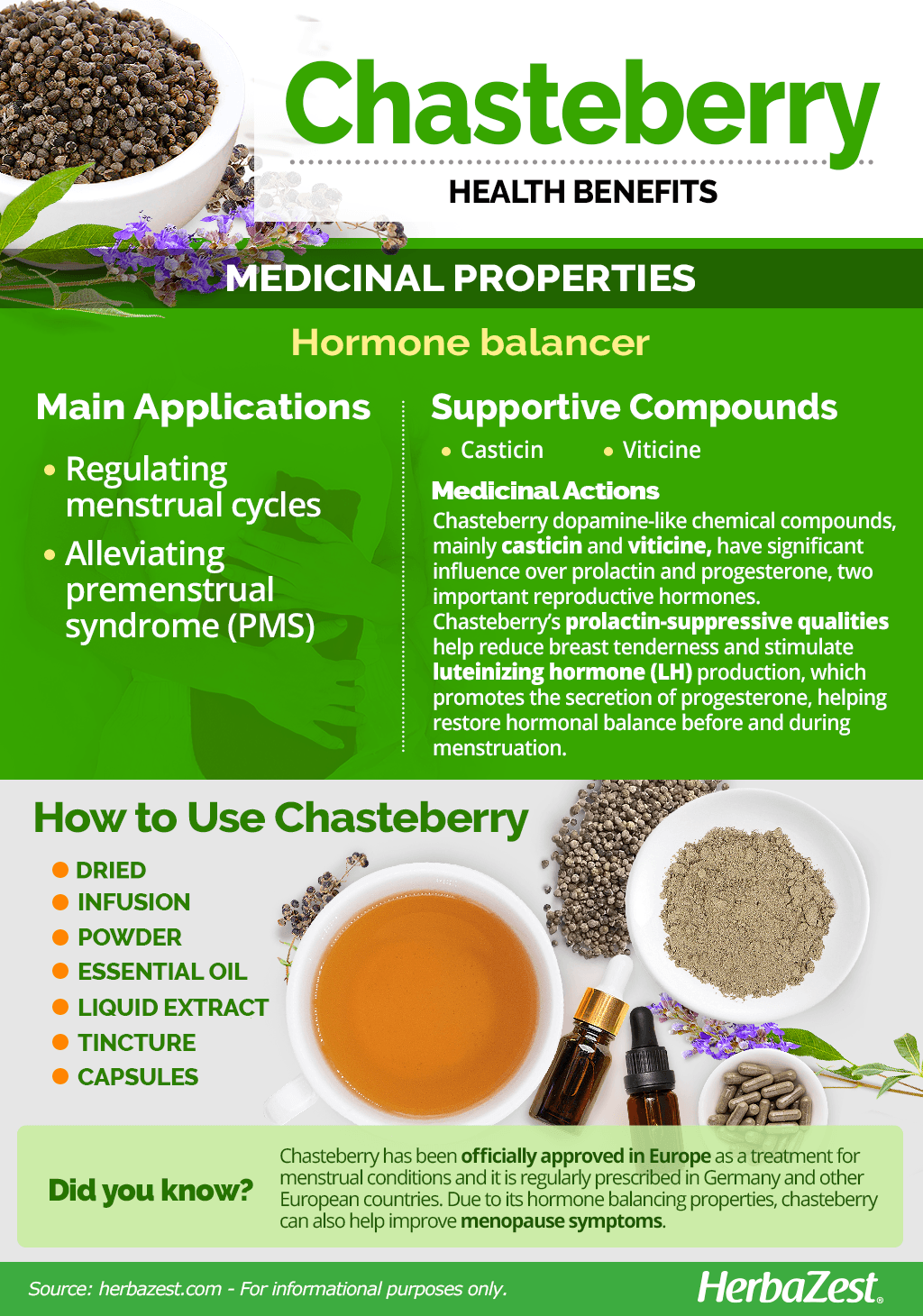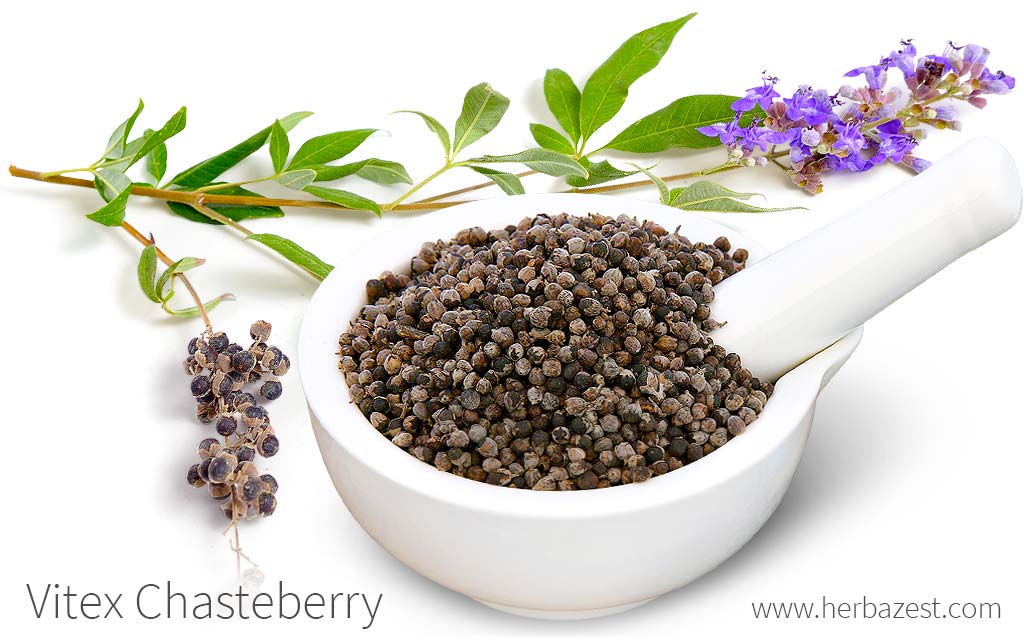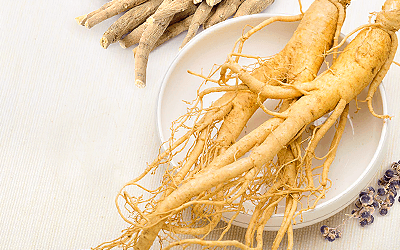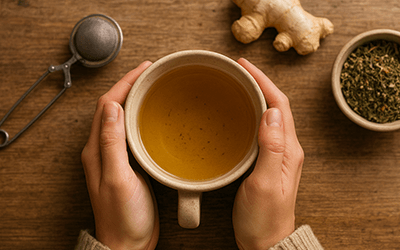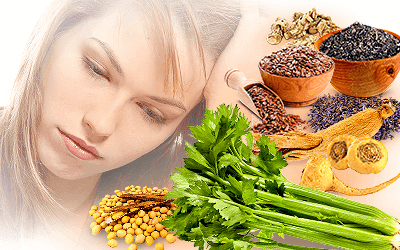Chasteberry, used in a variety of medicinal applications throughout history, is the fruit of a shruby tree native to Western Asia and the Mediterranean. While the chaste tree is widely appreciated for its beautiful flowers, chasteberries have also been studied and prescribed throughout history as a remedy for various symptoms - most notably menstrual complains - and have shown some legitimate benefits for women.
Chasteberry Medicinal Properties
- Medicinal action Hormone balancer
- Key constituents Casticin, viticine
- Ways to use Capsules, Hot infusions/tisanes, Liquid extracts, Tincture, Essential oil, Dried
- Medicinal rating (3) Reasonably useful plant
- Safety ranking Use with caution
Health Benefits of Chasteberry
The efficacy of chasteberry on problematic menstrual symptoms in women have been suggested by various scientific studies, many of them reporting noticeable changes in hormone levels that influence the intensity of premenstrual syndrome, cyclical irregularities, and breast tenderness.
Chasteberry has been officially approved in Europe as a treatment for menstrual conditions and it is regularly prescribed in Germany and other European countries.
Modern scientific studies have suggested the following chasteberry benefits:
Regulating menstrual cycles. Chasteberry benefits for reproductive health include improving irregular periods as well as the length and intensity of menstruation.
Alleviating premenstrual syndrome (PMS). Chasteberry can also reduce PMS symptoms by promoting hormonal balance before and during menstruation, and its therapeutic effects include reducing breast pain.
Other traditional uses of chasteberry, or Vitex, include enhancing breast milk production and boosting fertility.
How It Works
Chasteberry contains the flavonoid casticin and the alkaloid viticine, among other unique phytonutrients. The plant's therapeutic properties are mainly due to its effects on the hormones prolactin and progesterone. Excessive prolactin secretion during and before menstruation and imbalances in the ratio of estrogen to progesterone have a direct causal relationship with menstrual irregularities, breast tenderness, and premenstrual syndrome. Dopamine-like chemical compounds present in chasteberry have clinically demonstrated prolactin-suppressive qualities, thereby reducing breast tenderness and possibly other menstrual symptoms.1,2
For women with luteal phase disorders - or menstrual irregularities - chasteberry treatment has proven effective in some studies in lowering prolactin levels, improving progesterone synthesis, and regulating abnormal periods. Excess prolactin and luteal phase disorders are also causes of premenstrual syndrome, along with estrogen and progesterone imbalance. It is believed that chasteberry may stimulate lutenizing hormone through the pituitary gland, which then stimulates production of progesterone, potentially creating a greater balance of hormones before and during menstruation.3,4
EVIDENCE SEEMS TO SUPPORT THE USE OF CHASTEBERRY FOR SYMPTOMS OF PMS AND CYCLICAL BREAST DISCOMFORT.
Other herbs that can alleviate the symptoms of premenstrual syndrome and promote hormone balance are aguaje, black cohosh, and maca.
Chasteberry Side Effects
Chasteberry is not known to cause any serious side effects but may cause mild stomach discomfort, tiredness, dizziness, or dry mouth. It is not reported to interact with any drugs, and is largely well-tolerated.
Cautions
Chasteberry is contraindicated during pregnancy, and its use during lactation is not recommended. Because chasteberry is dopaminergic, those taking dopamine-related medications should avoid using chasteberry. Women taking any form of hormone therapy may also want to avoid chasteberry, as it has an effect on hormone levels.
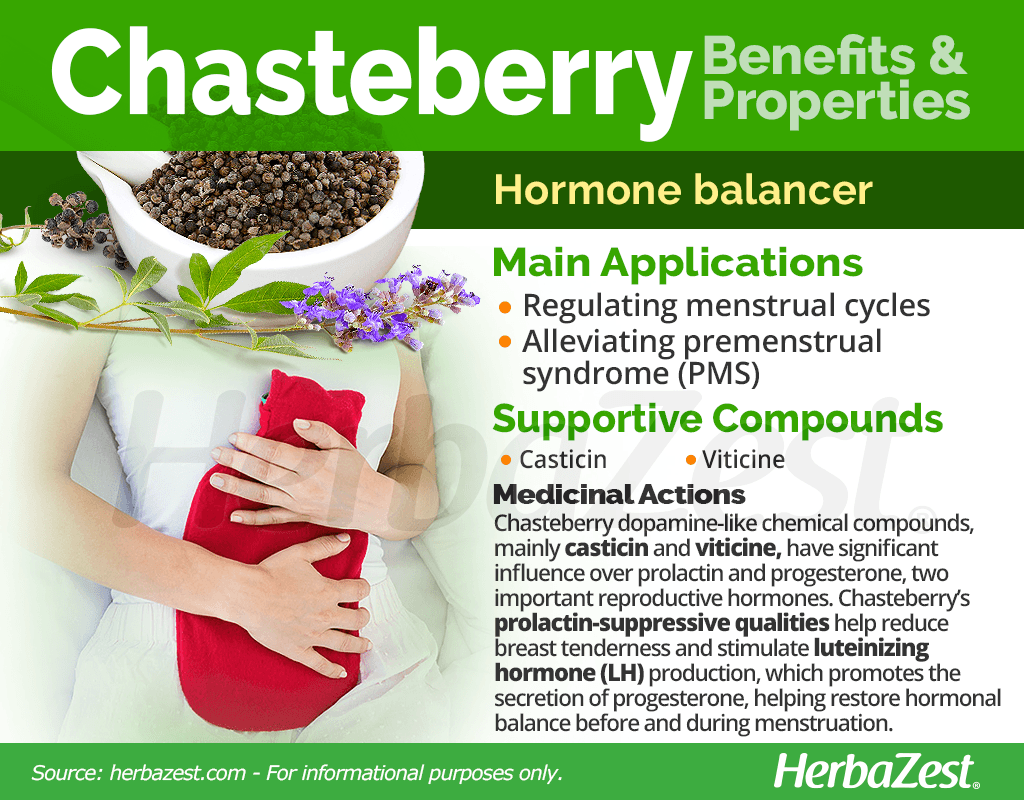
How to Consume Chasteberry
- Edible parts Fruit
- Taste Spicy
Due to its pungent, peppery taste, chasteberry have no use in the kitchen, but exclusively in medicinal preparations that concentrates the hormone balancing properties of this herb.
Natural Forms
Dried. The dried fruits of the chaste tree can be used in the preparation of homemade herbal remedies to alleviate PMS and menopause symptoms.
Infusion. Chasteberry tea is an easy way to reap the medicinal properties of this herb, and can be consumed with other herbs for an extra anti-inflammatory effect.
Powder. Once dried and pulverised, chasteberry powder can be added to infusions, shakes, and it also can be used in homemade herbal capsules.
Herbal Remedies & Supplements
- Essential oil. Whether it is inhaled or applied topically, Vitex essential oil can promote hormonal balance, reduce menstrual discomfort, and improve menopausal symptoms.
Liquid extract. This preparation concentrates chasteberry benefits and should be diluted in water, juices, or infusions in order to reap its medicinal properties.
Tincture. This type of preparation is commonly obtained from macerating chasteberries in a neutral alcohol in order to extract its healing properties. Like liquid extracts, tinctures should be diluted in water or other beverages to be safely consumed.
Capsules. Due to its peppery flavor, capsules are arguably the most popular method of reaping Vitex berries medicinal properties.
Chasteberry recommended dosages may vary based on delivery method and intended effect, and it is adviced to consult to a qualified physician before consumption.

Growing
- Life cycle Perennial
- Harvested parts Fruit
- Light requirements Full sun
- Soil Light (sandy)
- Growing habitat Temperate climates, Subtropical regions
The chaste tree can be grown either as a bush or a small tree, and it grows beautiful violet flowers, which make it a beautiful addition for a garden or urban landscape. With patience, and due the right climate and soil conditions, chasteberry plants can be cultivated by home-gardeners.
Growing Guidelines
The chasteberry plant requires full sun and well-drained soil to thrive.
It is best to avoid using rich, organic soils because they retain too much water close to the roots. Inorganic mulch - such as pebbles and rocks - are recommended to allow for proper drainage.
Once established, the chaste tree do not require much water.
It is advised to fertilize and prune chaste trees approximately once a year.
Flower spikes should be removed when they begin to fade, as if they are allowed to go to seed, there will be a reduced flower growth later in the season.
Though the chaste tree is hardy in USDA zones 7 to 8, often survives moderate winters and display new growth the following year, it is not considered truly hardy for winters throughout USDA zones 5 and 6.
CHASTEBERRY IS AN EXCELLENT CHOICE FOR A LARGE SHRUB OR SMALL FLOWERING TREE IN THE MODERN SUBURBAN LANDSCAPE.
Additional Information
Biology of Chasteberry
The chaste tree, also known as Vitex, chasteberry tree, and monk's pepper, among other popular names, is native to Europe and Asia. In warmer climates, it is generally grown as a deciduous shrub, and can reach 10 - 15 feet (3.0 - 4.5 m), or when trained to a single-trunk, it can grow up to 20 feet (60 m). However, in cooler climates, it may be grown as an herbaceous perennial that can grow up to 3 - 5 feet (90 - 150 cm). It is characterized by long, five to seven fingered, fragrant leaves and tall, loose spires of aromatic flowers in pink, white, blue, and violet.
Classification
Chaste tree, or Vitex agnus-castus, which grows largely in the Mediterranean, Central Asia, and Southern Europe, belongs to the family Verbenaceae, also known as verbena or vervain. This family of flowering shrubs and herbs comprises 35 genera and 1,200 species worldwide. Other economically important herb, to whom the vervain family owes its name, is lemon verbena (Aloysia citriodora).
Varieties and Cultivars
Vitex is one of the largest genus of the Verbenaceae family, with 250 recognized species, all of them deciduous shrubs. Vitex species that have been traditionally used for medicinal purposes include Vitex agnus-castus, native to the Mediterranean, Sourthern Europe and Central Asia; Vitex negundo, which naturally occur in Pakistan, India, and Sri Lanka; and Vitex rotundifolia, indigenous from Mediterranean region, Central Asia, and South to North of China.
There are many Vitex cultivars that are popular among gardeners due to their beautiful flowers; these include: 'Alba' (white blooms), 'LeCompte' (lilac), 'Montrose Purple' (blue-purple), 'Salinas Pink', and 'Sensational' (blue).
Historical Information
The earliest uses of chasteberry can be traced back 2,500 years ago, to the dawn of Greek history and the later Roman Empire, and it has always been linked to gynecological issues.
During Medieval times, the chasteberry tree was higly valued by monks. They would consume chasteberries in herbal preparations in order to reduce libido and ensure celibacy. However, this traditional application is not evidence-based or supported by current scientific research. Nuns, on the other hand, would use the herb for treating menstrual complains and menopausal symptoms as well.
Economic Data
The largest exporters of chasteberry are China, Spain, and the United States of America. As usual in the medicinal herbs global market, inspite of its importance, chasteberry economical data is not available.
Popular Beliefs
The chaste tree was an important part of Thesmosphoria, a Greek fertility ritual. A Vitex branchwas placed under the couches of women, in order to ensure chastity during the three days ceremony, after which they would allegedly increase their chances of conceiving.
Other Uses
Gardening and landscaping. Because their height and beutiful flowers, chaste trees are popular in gardens, parks, and other open spaces.
Sources
- Biochemical Pharmacology, Opioidergic mechanisms underlying the actions of Vitex agnus-castus L, 2011
- Drug Safety, Vitex agnus-castus: a systematic review of adverse events, 2005
- European Medicines Agency, Assessment report on Vitex agnus-castus L., fructus, 2018
- Johns Hopkins Medicine, Mastalgia (Breast Pain)
- National Public Radio, Plant Profiles: Vitex agnus-castus
- Texas A&M Agrilife Extension, Vitex, or Chaste Tree
- USDA Plants Database, Forest Service: Vitex agnus-castus Chastetree
- Encyclopedia of Herbal Medicine, p. 151
- NCCAM Herbs at a Glance, Chasteberry
- Medicinal Plants of the World, p. 343
- Phytomedicine, Chaste tree (Vitex agnus-castus)--pharmacology and clinical indications, 2003
- Pharmacognosy Reviews, The genus Vitex: A review, 2013
Footnotes:
- Phytomedicine. (2003). Chaste tree (Vitex agnus-castus)--pharmacology and clinical indications. Retrieved July 21, from: https://pubmed.ncbi.nlm.nih.gov/12809367/
- Maturitas. (2009). Treatment for premenstrual syndrome with Vitex agnus castus: A prospective, randomized, multi-center placebo controlled study in China. Retrieved July 21, from: https://pubmed.ncbi.nlm.nih.gov/19269753/
- Planta Medica. (2013). Vitex agnus-castus extracts for female reproductive disorders: a systematic review of clinical trials. Retrieved July 21, from: https://pubmed.ncbi.nlm.nih.gov/23136064/
- British Medical Journal. (2001). Treatment for the premenstrual syndrome with agnus-castus fruit extract: prospective, randomised, placebo controlled study. Retrieved August 7, 2023, from: https://pubmed.ncbi.nlm.nih.gov/11159568/
